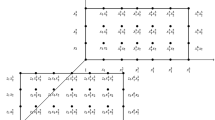Abstract.
In a paper from Chen, Reed, Helleseth and Truong, [10] (cf. also Loustaunau and York [10]) Gröbner bases are applied as a preprocessing tool in order to devise an algorithm for decoding a cyclic code over GF(q) of length n. The Gröbner basis computation of a suitable ideal allows us to produce two finite ordered lists of polynomials over GF(q),
upon the receipt of a codeword, one needs to compute the syndromes and then to compute the maximal value of the index i s.t. the error locator polynomial is then
The algorithm proposed in [4] needs the assumption that the computed Gröbner basis associated to a cyclic code has a particular structure; this assumption is not satisfied by every cyclic code. However the structure of the Gröbner basis of a 0-dimensional ideal has been deeply analyzed by Gianni [7] and Kalkbrenner [8]. Using these results we were able to generalize the idea of Chen, Reed, Helleseth and Truong to all cyclic codes.
Similar content being viewed by others
Explore related subjects
Discover the latest articles and news from researchers in related subjects, suggested using machine learning.Author information
Authors and Affiliations
Additional information
Received: June 25, 2001
Rights and permissions
About this article
Cite this article
Caboara, M., Mora, T. The Chen-Reed-Helleseth-Truong Decoding Algorithm and the Gianni-Kalkbrenner Gröbner Shape Theorem. AAECC 13, 209–232 (2002). https://doi.org/10.1007/s002000200097
Issue Date:
DOI: https://doi.org/10.1007/s002000200097



